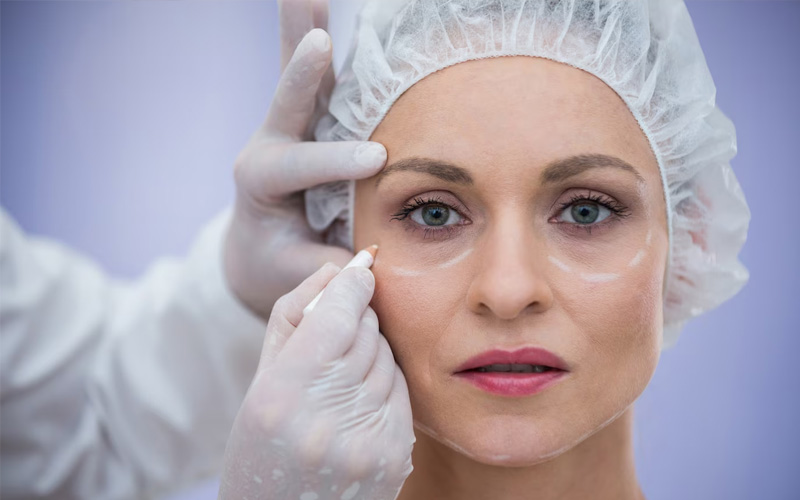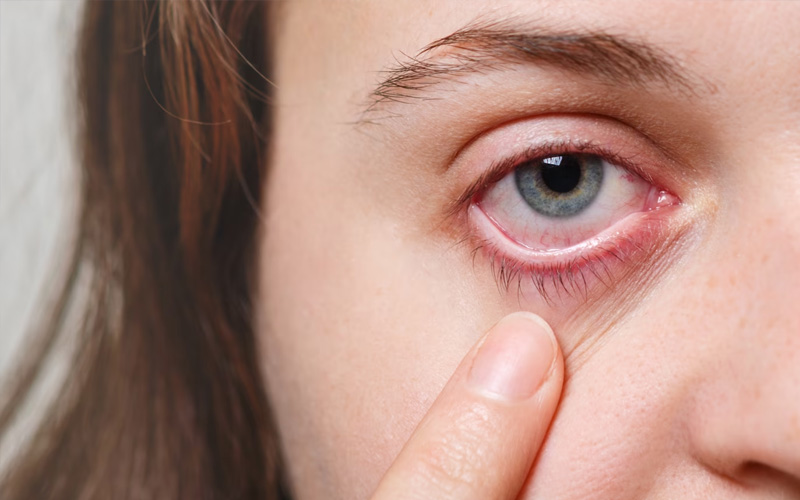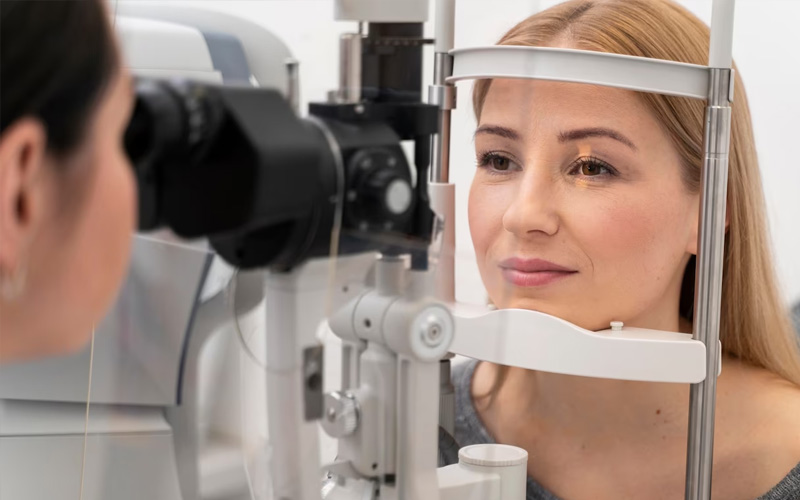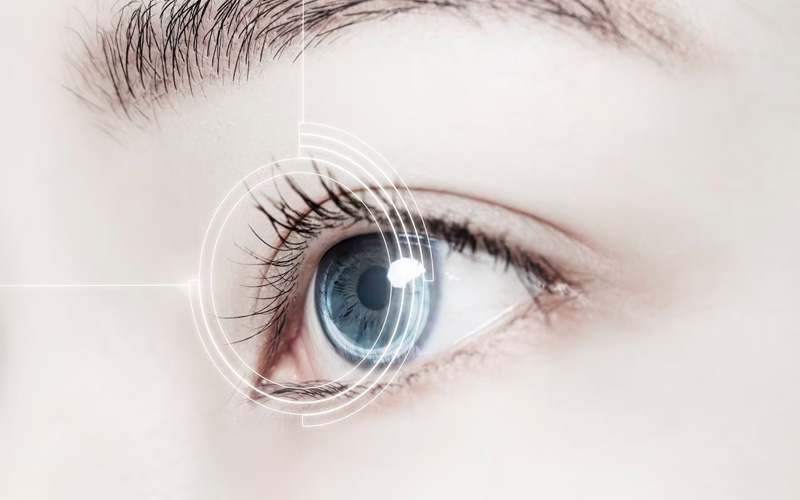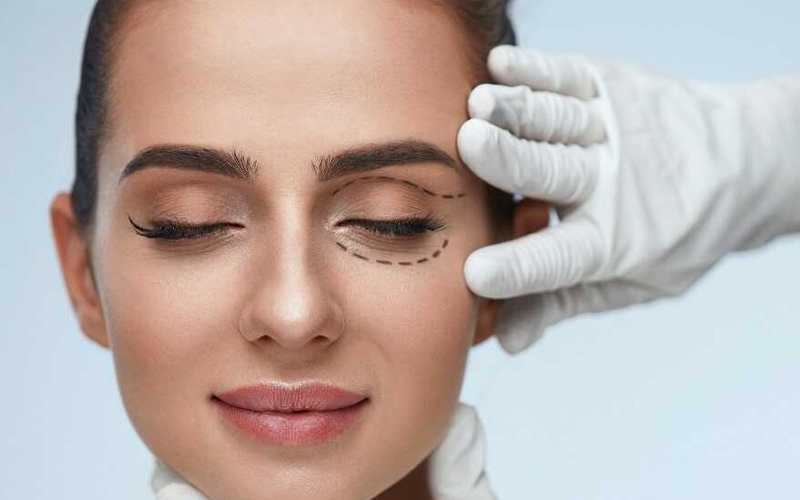What is Eyelid Aesthetics (Blepharoplasty)
Eyelid aesthetics, or blepharoplasty, which can be translated as eyelid lift surgery, has become one of the most commonly performed surgical procedures in recent years.
According to recent statistics, it has become the most frequently applied aesthetic surgical procedure on the face.
Following eyelid aesthetics, rhinoplasty (nose surgery) ranks second. Every year, hundreds of thousands of people undergo eyelid aesthetics both in Turkey who are coming from abroad.
From the perspective of medical tourism, many patients come to Turkey for facial and eye-related procedures and surgeries.
One of the main reasons for the increase in eyelid operations in recent years is that the eyelids and surrounding tissues are the first areas where effects of aging become apparent. Considering their anatomical location and function, individuals seeking eyelid aesthetics may do so either for cosmetic reasons or to eliminate sagging, heavy eyelids.
Swollen and drooping eyelids, along with excess skin which is sagging and obstructing the visual field, can interfere with vision and visual fields.
Additionally, changes caused by time and gravity can sometimes give the face a different expression, leading individuals to feel dissatisfied with their appearance. Similarly, under-eye bags, hollows, and dark circles can cause more significant issues than just aesthetic concerns.
Blepharoplasty surgery primarily involves removal of excess skin (which is accumulating and sagging on the eyelids), repositioning of fat pads around the eyes that, due to tissue laxity, sometimes herniate and create heaviness and fullness in the upper lids and bags under the eyes.
The surgery also includes tightening weakened muscle structures and repositioning vital tissues, such as the tear glands, if necessary. It is, in fact, a highly complex and delicate surgical procedure.
If there is a congenital or acquired eyelid deformity, it can also be corrected during the operation. Likewise, if the patient has ptosis (droopy upper eyelid), this condition can be and should be repaired in the same session through an additional surgical procedure.
One important aspect of blepharoplasty is the necessity to evaluate the face as a whole.
Everyone’s facial structure is shaped by their family history and genetic makeup. Over the years, deformities alter this facial structure, but these changes will manifest differently in each individual.
Moreover, when evaluating the face, position of the eyebrows, width of the forehead, and hairline must be considered, along with the midface and lower eyelid transition line.
Additionally, the shape and position of the nose, chin, lips, and cheeks must also be taken into account.
Therefore, blepharoplasty is more than just an eyelid aesthetic procedure—it is a crucial surgical intervention that enhances the overall harmony of the face.
Any individual over the age of 18 who is mentally healthy can undergo an eyelid aesthetics (blepharoplasty) procedure. The primary factors contributing to the deterioration of eyelid structure include familial facial features, genetic factors, time, and gravity. Additionally, prolonged exposure to UV radiation, such as spending long hours in the sun, and harmful habits like smoking, accelerate the aging process of the entire body and face, causing significant damage to the eyelids and surrounding tissues.
Certain medical conditions, such as thyroid disorders and other illnesses, are also known to have various effects on the periocular tissues and eyelids.
Regardless of the cause, with the right diagnosis and appropriate treatment, it is possible to eliminate excess tissue on the eyelids and achieve a healthier and more aesthetically pleasing appearance.
When performed on the right patients with the correct techniques, blepharoplasty can result in lasting and satisfactory improvements around the eyes and face.
Sagging, drooping, and heavy eyelids not only affect aesthetics but can also impair vision, disrupting the patient’s quality of life. In such cases, blepharoplasty not only enhances the appearance but also contributes to improved vision. The weight and drooping of the eyelids can restrict the visual field, and post-surgery, many patients experience a noticeable expansion in their field of vision.
Additionally, when heavy upper eyelids force the forehead muscles to lift the drooping eyelids, premature forehead wrinkles can develop. Some patients may unintentionally tilt their chin upward, which can lead to changes in head posture and neck problems. Blepharoplasty is crucial for resolving such issues. Studies have also shown that tighter, healthier eyelids can improve the distribution and drainage of tears across the eye surface.
Furthermore, eliminating sagging, loose upper eyelids and baggy, drooping lower eyelids helps remove the tired, worn-out appearance, resulting in a younger, healthier, and more aesthetically pleasing look.
One of the most critical aspects of blepharoplasty is selecting and applying the method that best suits the structure of the face, eyes, and eyebrows. At this stage, the relationship between the patient and the doctor is crucial.
During the preoperative consultation for blepharoplasty, the patient and doctor should discuss expectations and possibilities, clarifying all details. Reviewing the chosen surgical method and potential outcomes together helps minimize surprises for both the patient and the surgeon after the procedure. Occasionally, certain medical aesthetic treatments may also be combined with blepharoplasty.
The timing and combination of such treatments with blepharoplasty should be discussed and decided upon during the pre- and post-operative consultations between the patient and the doctor.
With expert surgical skills, proper patient selection, and a healthy patient-doctor relationship from the initial consultation to the post-operative period, blepharoplasty can yield highly successful results, either as a stand-alone procedure or in combination with other medical aesthetic treatments.
For surgical procedures involving the eyelids and surrounding tissues (including blepharoplasty), local anesthesia is generally preferred. One of the key reasons for this is the ability to evaluate the shape and form of the eyelids in different positions during the procedure. The patient’s ability to communicate with the surgeon is another advantage of performing the operation under local anesthesia. Additionally, local anesthesia offers the convenience of being performed in an office or clinic setting.
However, a comprehensive ophthalmological examination must be conducted for all patients planning to undergo eyelid surgery. This includes assessing visual acuity and performing biomicroscopic and fundus examinations. The surrounding eye area should also be carefully evaluated. If other conditions, such as dry eye or glaucoma, are present, they should be identified and assessed to determine whether they pose any contraindications to surgery.
Furthermore, systemic diseases, a history of accidents or trauma, and the patient’s overall medical history should be thoroughly reviewed.
Blepharoplasty can be planned for the upper and lower eyelids either separately or during the same session. While it is commonly performed under local anesthesia, it can also be carried out under general anesthesia. The method to be used should be specifically chosen for each patient, and the planned approach, potential benefits, and expectations should be discussed with the patient before the surgery.
For upper eyelid blepharoplasty, if ptosis (drooping eyelid) is present, it is recommended to correct it during the same session. Surgical incisions can be made along the eyelid creases or the inner surface of the eyelids.
Patients are typically discharged on the same day as the surgery, with no need for hospitalization. The eyes are not bandaged, but the incision sites may be covered with sterile strips. Ice packs are recommended in the first few days post-surgery to reduce swelling and bruising. Any stitches placed during the procedure (if applicable) are usually removed within 7–10 days.
Hospitalization is generally not required after the procedure.
Since the eyes are not covered postoperatively, activities such as reading, writing, watching television, and using a computer are allowed from the first day. However, it is recommended to spend the first few days resting at home, applying ice packs, and following prescribed medical treatments. This approach helps the face and body recover more comfortably from the trauma of surgery. One of the advantages of blepharoplasty is that it typically does not cause significant pain after the procedure.
There may be swelling and bruising around the eyelids and the soft tissues surrounding the eyes. Still, most patients can return to light social activities and non-strenuous work within 2–3 days. However, resuming heavy activities and full-capacity work may take more time. Swelling and bruising usually begin to subside within 7–10 days, and any stitches, if used, are removed. By the 15–20 day post-operative period, most patients can return to their normal daily lives. At this stage, all types of sports and makeup applications are allowed, though minor healing will still continue.
Complete healing of incision marks (if any), resolution of swelling, and the full normalization of eyelid and surrounding tissues may take 6–8 months or even up to 1 year. Despite this, the results of blepharoplasty are typically long-lasting, often remaining effective for many years, even decades.
Understanding and preventing the risks associated with blepharoplasty surgery require a thorough knowledge of the anatomy and physiology of the face, eyes, and surrounding tissues. The eyelids and adjacent tissues are among the most delicate areas of the face. Due to their mobility and their role in protecting the eyes, they must be approached with great care.
The skin of the eyelids is the thinnest in the entire body. Combined with the muscles responsible for eyelid movement and facial expressions, this delicate skin structure makes wrinkles and looseness in the eye area apparent at an early age. As a result, the earliest signs of aging are often observed around the eyes. Additionally, critical structures such as the lacrimal glands, extraocular muscles, and the optic nerve are closely associated with the surrounding tissues and must be carefully preserved during blepharoplasty planning.
The relationship between the structures of the face and the eyelid tissues should also be evaluated carefully. Today, the connection between the midface and lower eyelids has become particularly significant. Ignoring midface tissues in a lower blepharoplasty operation can negatively affect surgical success. Similarly, the relationship between the upper eyelids, eyebrows, and forehead must be considered. Upper blepharoplasty surgery planned without evaluating these areas may fail to achieve the desired outcome.
Regardless of the planned procedure, preserving the eyes—and therefore vision—is the top priority.
As mentioned earlier, maintaining strong communication between the patient and surgeon throughout the entire process is crucial. Setting realistic expectations, selecting the most appropriate method, and ensuring mutual understanding and agreement on all aspects are essential for achieving the best results.
In a delicate procedure like blepharoplasty, these considerations are critical to preventing any adverse outcomes during or after the process and to achieving the most successful and healthy results possible.
Finally, choosing a surgeon who specializes in blepharoplasty and is well-versed in the anatomy and physiology of the face, eyes, and surrounding tissues will significantly enhance surgical success, increase patient satisfaction, and minimize potential complications.
Blepharoplasty is generally a long-lasting surgical procedure with effects that can endure for many years. However, in rare cases, additional intervention may be required due to the natural effects of aging. In such situations, the most appropriate surgical approach should be carefully planned to suit the structure of the face and eyes.
In a small number of cases, a secondary surgical procedure may be needed in the early postoperative period if insufficient tissue was removed during the initial surgery. This situation is more accurately regarded as a complementary step to the original procedure rather than a full reoperation. Given the delicate and functional nature of eyelids, it is often better to take a conservative approach initially and perform minor adjustments in the early stages rather than risking more serious complications later.
That said, it is important to note that both scenarios are quite rare and are typically handled by the original surgeon who performed the initial procedure.
Revision blepharoplasty refers to procedures performed to correct complications or undesirable outcomes resulting from a previous blepharoplasty surgery.
These cases are often highly complex surgical interventions requiring significant expertise and extensive experience from an oculoplastic and facial plastic surgeon. While such complications are highly undesirable, they are unfortunately common worldwide, including in our country, due to the widespread practice of blepharoplasty.
Deformed eyelids, issues with opening and closing the eyelids, severe dry eye, and even vision problems are some of the complications that may arise after blepharoplasty. These situations can be deeply distressing for patients and significantly reduce their quality of life. Reaching an experienced surgeon skilled in the rehabilitation of such cases is the best course of action for achieving optimal results.




